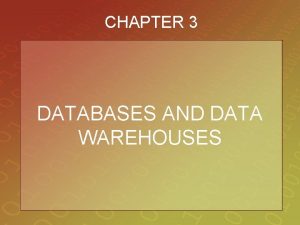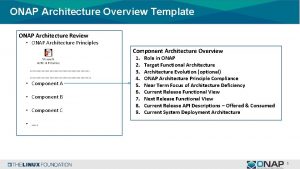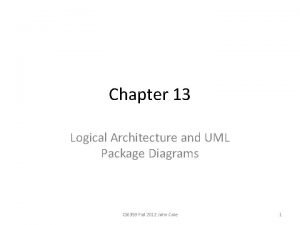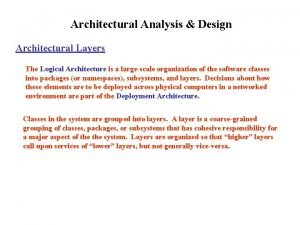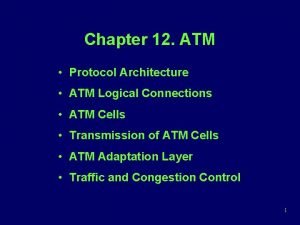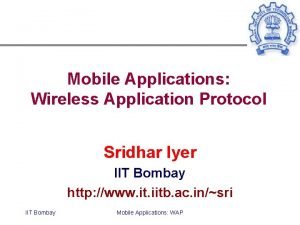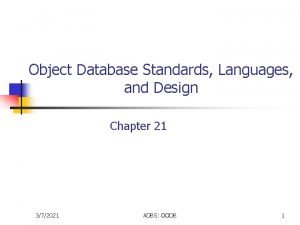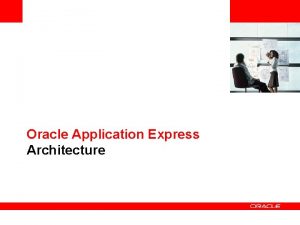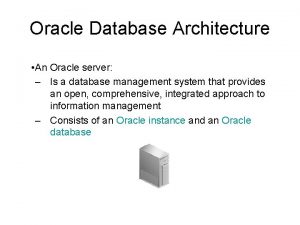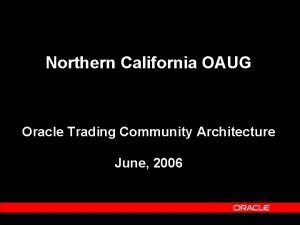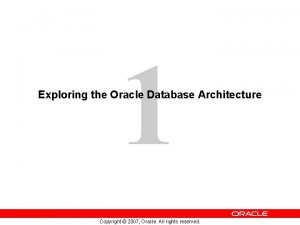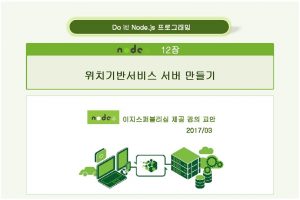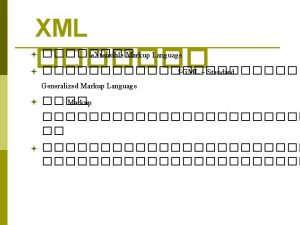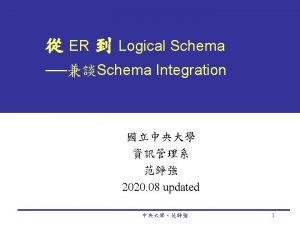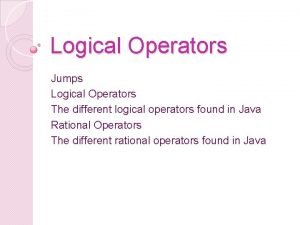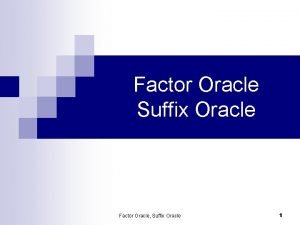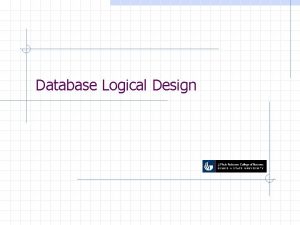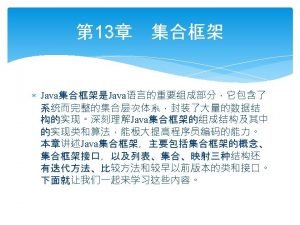Oracle Architecture Overview Oracle terms Schema logical collection


























- Slides: 26

Oracle Architecture Overview

Oracle terms • Schema – logical collection of user’s objects • Tablespace – logical space used for storage • Datafile – physical file used for storage • Extent – group of contiguous blocks • Block – unit of physical storage

Oracle Architecture • database vs. instance Database Instance Parameter files* Control files** Data files Redo Log files System Global Area (SGA) Background Processes Disk Memory * Parameter files include the init<SID>. ora and config<SID>. ora files. These are used to set options for the database. ** Control files contain information about the db in binary form. They can be backed up to a text file however.

Oracle vs. Access and My. SQL • Access – One. mdb file contains all objects – Limited roles/permissions • My. SQL – Three files per table – Permissions based on user, database, and host • Oracle – Many files – Many roles/permissions possible

The Oracle Data Dictionary • Collection of tables and views that show the inner workings and structure of the db • “static” data dictionary views – owned by SYS – created by catalog. sql script at db creation – contain DDL info • dynamic data dictionary views – also referred to as V$ views – based on virtual tables (X$ tables) – provide info about the instance

More Data Dictionary Create table samples ( ID number(3) primary key, Type varchar 2(5), Constraint type_ck check (type in (‘photo’, ’swatch’)) …); 1. Samples table created in user’s schema 2. Primary key index created in user’s schema (SYS_C 984620) 3. Data dictionary is also updated, with rows being inserted into tables underlying the following data dictionary views: User_objects User_constraints User_cons_columns And lots more…

Oracle Odds and Ends • Dual table SELECT 1+1*400 FROM DUAL; • % - the SQL wildcard SELECT ename FROM emp WHERE ename like ‘%neil%’; • inserting apostrophes INSERT INTO emp (name) VALUES (‘O’’Neill); • Case sensitive string matching UPDATE emp SET ename=UPPER(ename) WHERE ename='O''Neill';

Sysdate • Sysdate returns current system date AND time • use trunc function to remove time piece Example: select to_char (adate, ‘dd-mon-yy hh 24: mi: ss’) TO_CHAR(ADATE, ‘DD-MON-YY: HH 24: MI: SS’) 17 -feb-00 23: 41: 50 select adate from samples where trunc(adate)=‘ 17 -feb-00’; ADATE 17 -FEB-00

ROWID • ROWID is an internal number Oracle uses to uniquely identify each row • NOT a primary key! Is the actual location of a row on a disk. Very efficient for retrieval. • Format specifies block, row, and file (and object in 8) – Oracle 7: BBBBBBB. RRRR. FFFFF – Oracle 8: OOOOOO. FFF. BBBBBB. RRR • Called pseudo-column since can be selected

Outer joins in Oracle • Add (+) to table where nulls are acceptable SELECT * FROM emp, dept WHERE emp. deptno(+)=dept. id;

Oracle SQL functions • Upper(), lower() • Substr(), replace(), rtrim(), concat() • Length() • Floor(), sqrt(), min(), max(), stddev() • Add_months(), months_between(), last_day() • To_date(), to_char(), to_lob()

More functions • nvl() – If NULL, return this instead… Nvl(lastname, ’Anonymous’) • decode() – Sort of like an If/Then statement… Decode(gender, 0, ’Male’, 1, ’Female’, ’Unknown’)

Oracle error messages • Divided into groups by first three letters (e. g. ORA or TNS) • Number gives more information about error • Several messages may be related to only one problem • oerr facility

Constraints • • Primary key Foreign key Unique, not null Check CREATE TABLE test ( id NUMBER(2), col 2 VARCHAR 2(2), col 3 VARCHAR 2(3), CONSTRAINT test_pk PRIMARY KEY(id), CONSTRAINT col 3_ck CHECK (col 3 IN ('yes', 'no')) ); • Name your constraints • User_constraints, user_cons_columns

SELECT user_constraints. constraint_name, constraint_type, user_constraints. search_condition FROM user_constraints, user_cons_columns WHERE user_constraints. table_name=user_cons_columns. table_name AND user_constraints. constraint_name=user_cons_columns. constraint_name AND user_constraints. owner=user_cons_columns. owner AND user_constraints. table_name=‘TEST’; NAME T SEARCH_CONDITION -------- - ------------COL 3_CK C col 3 IN ('yes', 'no') TEST_PK P

Constraints • Oracle naming of constraints is NOT intuitive! • enabling and disabling disable constraint_name; • the EXCEPTIONS table – run utlexcpt. sql to create EXCEPTIONS table then – alter SQL statement: SQL_query EXCEPTIONS into EXCEPTIONS;

More objects • Sequences – creating the sequence create sequence Customer. ID increment by 1 start with 1000; – selecting from the sequence insert into customer (name, contact, ID) values (‘TManage’, ’Kristin Chaffin’, Customer. ID. Next. Val); • Curr. Val is used after Next. Val for related inserts • Synonyms – provide location and owner transparency – Can be public or private

PL/SQL - Triggers • Executed on insert, update, delete • Use to enforce business logic that can’t be coded through referential integrity or constraints • Types of triggers – row level (use FOR EACH ROW clause) – statement level (default) – Before and After triggers • Referencing old and new values

Trigger example SQL> desc all_triggers; Name Null? ----------------OWNER TRIGGER_NAME TRIGGER_TYPE TRIGGERING_EVENT TABLE_OWNER BASE_OBJECT_TYPE TABLE_NAME COLUMN_NAME REFERENCING_NAMES WHEN_CLAUSE STATUS DESCRIPTION ACTION_TYPE TRIGGER_BODY Type ---VARCHAR 2(30) VARCHAR 2(16) VARCHAR 2(75) VARCHAR 2(30) VARCHAR 2(16) VARCHAR 2(30) VARCHAR 2(4000) VARCHAR 2(128) VARCHAR 2(4000) VARCHAR 2(11) LONG

Trigger example (cont. ) SQL> select trigger_name from all_triggers where owner='SCOTT'; TRIGGER_NAME ---------------AFTER_INS_UPD_ON_EMP set lines 120 col trigger_name format a 20 col triggering_event format a 18 col table_name format a 10 col description format a 26 col trigger_body format a 35 select trigger_name, trigger_type, triggering_event, table_name, status, description, trigger_body from all_triggers where trigger_name='AFTER_INS_UPD_ON_EMP';

Trigger example (cont. ) SQL> / TRIGGER_NAME TRIGGER_TYPE TRIGGERING_EVENT TABLE_NAME STATUS DESCRIPTION ------------------ -----------TRIGGER_BODY -----------------AFTER_INS_UPD_ON_EMP BEFORE EACH ROW INSERT OR UPDATE EMP ENABLED scott. after_ins_upd_on_emp before insert or update on scott. emp for each row begin : new. ename : = upper(: new. ename); end; The above trigger was created with the following statement: create or replace trigger scott. after_ins_upd_on_emp before insert or update on scott. emp for each row begin : new. ename : = upper(: new. ename); end;

Remember those views? • Query USER_TRIGGERS to get trigger info • Query USER_SOURCE to get source of procedure, function, package, or package body • Query USER_ERRORS to get error information (or use show errors) col name format a 15 col text format a 40 select name, type, text from user_errors order by name, type, sequence; • Query USER_OBJECT to get status info

Understanding Indexes • Index overhead – impact on inserts, updates and deletes – batch inserts can be slowed by indexes - may want to drop, then recreate – rebuilding indexes • Use indexes when query will return less than 5% of rows in a large table • Determining what to index – All primary and foreign keys – Examine SQL and index heavily hit, selective columns (columns often found in where clauses)

What not to Index…preferably • columns that are constantly updated • columns that contain a lot of null values • columns that have a poor distribution of data – Examples: • yes/no • true/false • male/female

B*-tree index Miller < Miller > Miller < Davis Jones Adams Brown Culver Deal Howard Isis Branch blocks Smith Turner > Jules Klein Main Moss Porter Sikes Deal – ROWID Howard – ROWID Detail of leaf node Isis - ROWID Sykes Thomas Topper Vera Wagner Yanks Leaf blocks

Bitmap index Parts table partno 1 2 3 4 color size GREEN RED BLUE MED SMALL LARGE Bitmapped index on ‘color’ color = ‘BLUE’ 0 0 0 1 color = ‘RED’ 0 1 1 0 color = ‘GREEN’ 1 0 0 0 Part number 1 2 3 4
 Overview of oracle architecture
Overview of oracle architecture Logically equivalent statements
Logically equivalent statements Hukum kesetaraan logis
Hukum kesetaraan logis A data warehouse is a logical collection of information
A data warehouse is a logical collection of information Landsat collection 1 vs collection 2
Landsat collection 1 vs collection 2 Types of documentary collection
Types of documentary collection Physical and logical structure of oracle database
Physical and logical structure of oracle database Like terms and unlike terms in polynomials
Like terms and unlike terms in polynomials Like terms in algebra
Like terms in algebra Onap architecture
Onap architecture What is stylistic overview
What is stylistic overview Gsm reference architecture
Gsm reference architecture Overview of grid architecture
Overview of grid architecture Logical architecture and uml package diagram
Logical architecture and uml package diagram Wap protocol stack
Wap protocol stack Logical architecture example
Logical architecture example Logical architecture definition
Logical architecture definition Atm protokol
Atm protokol Wta logical architecture
Wta logical architecture Naval architecture terms
Naval architecture terms Architecture terms
Architecture terms Mapping an eer schema to an odb schema
Mapping an eer schema to an odb schema Oracle apex architecture diagram
Oracle apex architecture diagram Oracle maa architecture
Oracle maa architecture Oracle database server architecture
Oracle database server architecture Oracle trading community architecture
Oracle trading community architecture Exploring the oracle database architecture
Exploring the oracle database architecture



